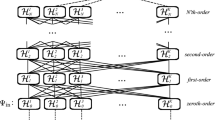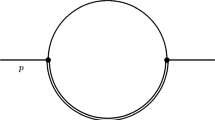Summary
The Veneziano beta-function transform technique is generalized to the case in which there are several asymptotic variables. The multiple transform of a dual-tree amplitude is found to be again a dual-tree amplitude apart from a well-defined redefinition of the trajectories. The asymptotic behavior of dual amplitudes is discussed, with particular emphasis on the analytic structure in the complex-angular-momentum like plane.
Riassunto
Si generalizza la tecnica della trasformata della funzione beta di Veneziano al caso in cui vi sono parecchie variabili asintotiche. Si trova che la trasformata multipla di un’ampiezza ad albero duale è ancora un’ampiezza ad albero duale a prescindere da una ben definita ridefinizione delle traiettorie. Si discute il comportamento asintotico delle ampiezze duali, ponendo una particolare enfasi sulla struttura analitica nel piano del tipo del momento angolare complesso.
Реэюме
Техника преобраэований бета-функций Венециано обобшается на случай, в котором имеется несколько асимптотических переменных. Обнаружено, что многократное преобраэование дуальной древовидной амплитуды представляет снова дуальную древовидную амплитуду, не считая отчетливо выраженного уточнения определения траекторий. Обсуждается асимптотическое поведение дуальных амплитуд, причем, особое внимание уделяется аналитической структуре в комплексной плоскости, подобной плоскости момента.
Similar content being viewed by others
References
L. N. Chang, P. G. O. Freud andY. Nambu:Phys. Rev. Lett.,24, 628 (1970).
D. Gordon andG. Veneziano:Phys. Rev., to be published.
M. A. Virasoro:Phys. Rev., to be published.
C. E. De Tar, K. Kang, Chung-I Tan andJ. H. Weis: M.I.T. preprint C.T.P. 180, January 1971.
C. Lovelace: Rutgers University preprint, February 1971.
P. Olesen: CERN preprint (1971).
A. H. Mueller:Phys. Rev. D,2, 2963 (1970).
C. E. De Tar, C. E. Jones, F. E. Low, Chung-I Tan, J. H. Weis andJ. E. Young:Phys. Rev. Lett.,26, 675 (1970).
H. D. I. Abarbanel, G. F. Chew, M. L. Goldberger andL. M. Saunders: Princeton University preprint, 1971. We thankA. Pignotti for discussions concerning their work.
See,e.g.,K. Kikkawa:Phys. Rev.,187, 2249 (1969).
K. Bardakci andH. Ruegg:Phys. Lett.,28 B, 242 (1968).
G. Veneziano: invited paper at theFirst Coral Gables Conference on Fundamental Interactions at High Energy (January 1969).
We note that the vanishing of the triple Regge vertex occurs when the intercepts of the three parent trajectories are at unity, and all momentum transfer variables tend to zero, see for example eq. (3.22) of ref. (2).
M. Ademollo andE. Del Giudice:Nuovo Cimento,63 A, 639 (1969).
Chang Hong Mo:Phys. Lett.,28 B, 425 (1969).
For an interesting general discussion of the nontrivial relations which hold between different inequivalent permutations of a dual amplitudes, seeE. Plahte:Nuovo Cimento,66 A, 713 (1970). A beautiful application of the Plahte relations in the context of inclusive reactions may be found in ref. (4).
See,e.g.,S. J. Chang, D. Gordon, F. E. Low andS. B. Treiman: NAL preprint THY-16, to be published inPhys. Rev.
Bateman Manuscript Project:Higher Transcendental Functions, edited byA. Erdelyi, Vol.1 (New York, 1953), p. 256;E. T. Whittaker andG. N. Watson:A Course in Modern Analysis (London, 1952), p. 289.
The presence of double poles when α34=α01, in the double Regge limit of the five-point production amplitude had been noted in a model calculation involving sums of ladder graphs byW. J. Zakrzewski:Nuovo Cimento,60 A, 263 (1969).
N. F. Bali, G. F. Chew andA. Pignotti:Phys. Rev. Lett.,19, 614 (1967).
We note that for unit intercept the dual amplitudes are quite likely free of ghosts (M. A. Virasoro:Phys. Rev. D,1, 2933 (1970)). It is intriguing that a possible threat to unitarity appears suppressed in exactly the Virasoro case. We note, however, that we still have a problem due to the presence of the undesirable tachyon pole.
J. Finkelstein andK. Kajantie:Phys. Lett.,26 B, 305 (1968).
I. A. Verdiev, O. V. Kancheli, S. G. Matinyan, A. M. Popova andK. A. Ter-Martirosyan:Sov. Phys. JETP,19, 1148 (1964).
I. T. Drummond, P. V. Landshoff andW. J. Zakrzewski:Nucl. Phys.,11 B, 383 (1969);Phys. Lett.,28 B, 676 (1969).
P. Goddard andA. R. White: University of Cambridge preprint, June 1970;A. R. White: University of Cambridge preprint, October 1970.
S. Fubini andG. Veneziano:Nuovo Cimento,64 A, 811 (1969);K. Bardakci andS. Mandelstam:Phys. Rev.,184, 1640 (1969).
For single loop see,e.g.,D. J. Gross,A. Neveu,J. Scherk andJ. Schwarz:Phys. Rev. D,2, 697 (1970);Phys. Lett.,31 B, 592 (1970).
See,e.g., for multiloop amplitudes,C. Lovelace:Phys. Rev. Lett.,32 B, 703 (1970);V. A. Alessandrini: CERN preprint 1215 (1970).
Author information
Authors and Affiliations
Rights and permissions
About this article
Cite this article
Gordon, D. The Veneziano transform and the high-energy behavior of dual-resonance amplitudes. Nuov Cim A 6, 107–120 (1971). https://doi.org/10.1007/BF02723437
Received:
Published:
Issue Date:
DOI: https://doi.org/10.1007/BF02723437




